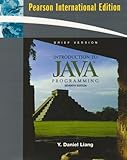Introduction to JAVA programming : brief version / Y. Daniel Liang.
Material type: TextPublication details: Upper Saddle River, NJ : Pearson/Prentice Hall, c2009.Edition: 7th edDescription: 733 p. ; 26 cmISBN:
TextPublication details: Upper Saddle River, NJ : Pearson/Prentice Hall, c2009.Edition: 7th edDescription: 733 p. ; 26 cmISBN: - 0138146268
- JAVA programming
- 005.133 22
| Item type | Current library | Call number | Copy number | Status | Date due | Barcode | |
|---|---|---|---|---|---|---|---|
 Books
Books
|
Main library General Stacks | 005.133 / LI.I 2009 (Browse shelf(Opens below)) | 1 | Available | 001792 |
Browsing Main library shelves, Shelving location: General Stacks Close shelf browser (Hides shelf browser)

|

|

|

|

|

|

|
||
| 005.133 / KE.B 1995 A book on C : | 005.133 / LA.F 2010 Fundamentals of Python : | 005.133 / LE.J 2010 Java software structures : | 005.133 / LI.I 2009 Introduction to JAVA programming : | 005.133 / LI.L 2009 learning C# 3.0 / | 005.133 / LI.P 2008 Programming C# 3.0 / | 005.133 / LI.S 2009 Sams teach yourself C++ in one hour a day / |
Includes index.
Chapter 1 Introduction to Computers, Programs, and Java -- Chapter 2 Elementary Programming -- Chapter 3 Selections -- Chapter 4 Loops -- Chapter 5 Methods -- Chapter 6 Single-Dimensional Arrays -- Chapter 7 Multidimensional Arrays -- Chapter 8 Objects and Classes -- Chapter 9 Strings and Text I/O -- Chapter 10 Thinking in Objects -- Chapter 11 Inheritance and Polymorphism -- Chapter 12 GUI Basics -- Chapter 13 Exception Handling -- Chapter 14 Abstract Classes and Interfaces -- Chapter 15 Graphics -- Chapter 16 Event-Driven Programming -- Chapter 17 Creating Graphical User Interfaces -- Chapter 18 Applets and Multimedia -- Chapter 19 Binary I/O -- Chapter 20 Recursion.
Introduction to Java Programming, Brief, 8e consists of the first 20 chapters from the Comprehensive version of Introduction to Java Programming. It introduces fundamentals of programming, problem-solving, object-oriented programming, and GUI programming. The Brief version is suitable for a CS1 course. Regardless of major, students will be able to grasp concepts of problem-solving and programming — thanks to Liang’s fundamentals-first approach, students learn critical problem solving skills and core constructs before object-oriented programming. Liang’s approach includes application-rich programming examples, which go beyond the traditional math-based problems found in most texts. Students are introduced to topics like control statements, methods, and arrays before learning to create classes. Later chapters introduce advanced topics including graphical user interface, exception handling, I/O, and data structures. Small, simple examples demonstrate concepts and techniques while longer examples are presented in case studies with overall discussions and thorough line-by-line explanations. In the Eighth Edition, only standard classes are used.
Includes bibliographical references and index.
1
There are no comments on this title.
